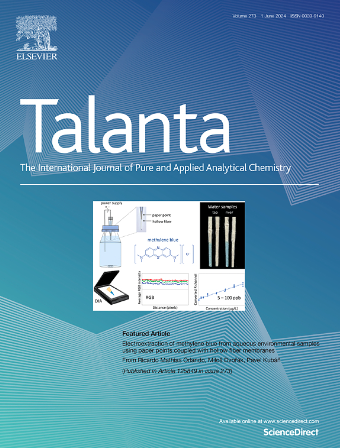农药硫丹可逆抑制Pt单原子过氧化物酶纳米酶的机理及其在比色传感硫丹中的应用
IF 5.6
1区 化学
Q1 CHEMISTRY, ANALYTICAL
引用次数: 0
摘要
纳米酶在基于催化的传感方面具有很大的前景。然而,对纳米酶的抑制机制研究较少,阻碍了其传感应用。在此,我们报道了一个灵敏的比色传感平台,用于检测农药四甲基硫脲二硫(thiram)基于Pt单原子纳米酶(SAN)基过氧化物酶(POD)样活性的抑制。含有二甲基二硫代氨基甲酸酯(DMDTC)单元的Thiram能够抑制Pt SAN的pod样活性,因为二硫键被切割成DMDTC, DMDTC进一步与Pt SAN形成Pt - s键。研究了酶与底物的相互作用及底物的抑制机制。Thiram对Pt SAN的pod样活性具有可逆抑制作用,表现为混合抑制(竞争抑制和非竞争抑制)和非竞争抑制,抑制常数(Ki)分别为9.079和0.382 mM。最后,基于抑制机理,构建了具有0.025-1 μM和1-15 μM两个线性部分的比色传感器,检出限为9.24 nM。该方法可用于实际样品中硫胺的检测,重现性好。这项工作不仅为研究其他纳米酶与抑制剂之间的抑制机制奠定了基础,而且为环境样品中痕量硫胺的检测提供了一种新的方法。本文章由计算机程序翻译,如有差异,请以英文原文为准。

Mechanism of pesticide thiram reversibly inhibiting of Pt single-atom peroxidase-mimicking nanozyme and its application in colorimetric sensing thiram
Nanozymes hold great promise in catalysis-based sensing. However, little attention has been paid to inhibition mechanism of nanozymes, which impeded their sensing application. Herein, we report a sensitive colorimetric sensing platform for detecting pesticide tetramethylthiuram disulfide (thiram) based on its inhibition of Pt single-atom nanozymes (SAN)-based peroxidase (POD)-like activity. Thiram containing dimethyl dithiocarbamate (DMDTC) unit capable of inhibiting POD-like activity of Pt SAN because the disulfide bond was cleaved to form DMDTC, which further formed Pt–S bond with Pt SAN. The enzyme-substrate interaction and the substrate's inhibitory mechanism were investigated. Thiram can inhibit the POD-like activity of Pt SAN reversibly with mixed inhibition (competitive inhibition and non-competitive inhibition) and uncompetitive inhibition with the inhibition constants (Ki) of 9.079 and 0.382 mM, respectively. Finally, based on the inhibition mechanism, a colorimetric sensor was constructed, exhibiting two linear parts of 0.025–1 μM and 1–15 μM with a detection limit of 9.24 nM thiram. The as-proposed method can be applied to detect thiram in real samples with good reproducibility. This work not only lays the foundation for study on the inhibition mechanism between other nanozymes and inhibitors, but also provides a new method for detecting trace thiram in environmental samples.
求助全文
通过发布文献求助,成功后即可免费获取论文全文。
去求助
来源期刊

Talanta
化学-分析化学
CiteScore
12.30
自引率
4.90%
发文量
861
审稿时长
29 days
期刊介绍:
Talanta provides a forum for the publication of original research papers, short communications, and critical reviews in all branches of pure and applied analytical chemistry. Papers are evaluated based on established guidelines, including the fundamental nature of the study, scientific novelty, substantial improvement or advantage over existing technology or methods, and demonstrated analytical applicability. Original research papers on fundamental studies, and on novel sensor and instrumentation developments, are encouraged. Novel or improved applications in areas such as clinical and biological chemistry, environmental analysis, geochemistry, materials science and engineering, and analytical platforms for omics development are welcome.
Analytical performance of methods should be determined, including interference and matrix effects, and methods should be validated by comparison with a standard method, or analysis of a certified reference material. Simple spiking recoveries may not be sufficient. The developed method should especially comprise information on selectivity, sensitivity, detection limits, accuracy, and reliability. However, applying official validation or robustness studies to a routine method or technique does not necessarily constitute novelty. Proper statistical treatment of the data should be provided. Relevant literature should be cited, including related publications by the authors, and authors should discuss how their proposed methodology compares with previously reported methods.
 求助内容:
求助内容: 应助结果提醒方式:
应助结果提醒方式:


